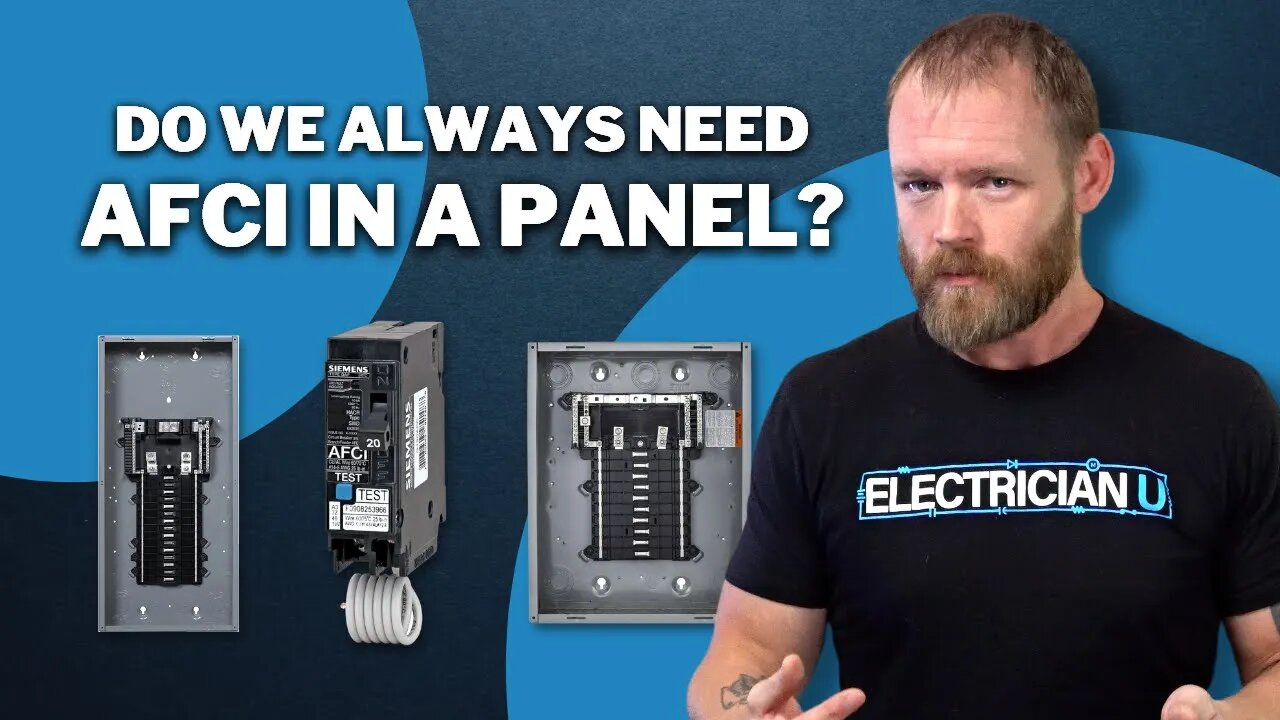Premium Only Content

Do We Always Need AFCI in a Panel? Is There an Exception?
Join this channel to get access to perks:
https://www.youtube.com/channel/UCB3jUEyCLRbCw7QED0vnXYg/join
I comment recently came in from one of our followers asking the question “Can you please point to the code section that requires upgrading to AFCI breakers when changing a panel”. In the latest episode of Electrician U, Dustin answers this question along with giving some advice surrounding the topic of upgrades in general.
🤘⚡️MEMBERSHIP⚡️🤘
JOIN ELECTRICIAN U - become a member and get:
FREE Continuing Education every year
FREE Practice Exams
FREE Monthly Video Courses
FREE Weekly Live Instructor-Led Classes
FREE Monthly Educational Newsletter
Premium Members-Only Content
Private Discord Channel
Monthly Members-Only Discord Chats
Sign up here --- https://www.electricianu.com/electrician-u-membership/
🎧🎹MUSIC AND VIDEO:🎹🎧
https://www.facebook.com/descantmv
🎬✍️ART AND ILLUSTRATION:✍️🎬
https://www.daverussoart.com
Article 210.12 of the NEC governs the installation of AFCI devices and article 210.12(E) covers branch circuit wiring extensions, modifications, or replacements (this is where the information covering the question asked above resides). In a nutshell, if you replace, modify, or extend a branch circuit in any of the areas requiring AFCI protection, and it isn’t present before you start the work, then you are required to install it. However, there is an exception that is very pertinent to this type of scenario. Article 210.12(E) exception states that “AFCI protection shall NOT be REQUIRED where the extension of the existing branch-circuit conductors is not more than 6 ft AND does not include any additional outlets or devices, other than splicing devices. This measurement shall not include the conductors inside an enclosure, cabinet, or junction box”. So, if you added a circuit, a receptacle to an existing circuit, or added wire longer than 6 feet, you would be required to AFCI protect that circuit. But, if you were just replacing the panel and not adding any receptacles to the branch circuit or extending the wiring for the existing branch circuits more than 6 feet, then you would not be required to add any AFCI protection to the installation.
Having said that!! The NEC is a document; a set of guidelines to follow for electrical installations. These guidelines are meant to provide as much protection as possible for personnel and property when it comes to electricity. In addition, the NEC (of which the 2020 version is the most current) generally speaks in minimums & maximums and shall & shall nots. You can always go above and beyond what is listed in this document, but never install a lesser product/installation than required. In fact, the municipalities that govern the local area that we do our work in have the final say so in whether it is allowed or not. So, it falls on the electrical contractor to adhere to the local AHJ’s version of what they want to see. So, some areas may want you to install the AFCI breakers when replacing a panel, and it is certainly within their right to request that. Make sure you know the requirements of your local jurisdiction before performing (or even giving an estimate for) the work.
You should also answer your customers questions and/or let them know exactly what you will be doing and why. They are not in the business of understanding the NEC or the local AHJ and by explaining exactly what you are doing and why (along with the associated costs that go along with it!!) will at least help to avoid some sticker shock when they get handed the bill!! It also pays dividends to know of the code changes between the last code version and the current code (we do have a new code cycle looming around the corner so be ready for the NEC code changes 2023) as they change every 3 years, and you would have been installing/understanding of the prior 3 years code. There are books available that list the changes, in addition to the changes being noted within the new code book by symbol.
We hope this has been helpful in understanding the requirements of adding AFCI protection in an existing panel. Is there a topic you would like to see discussed on Electrician U? Leave us a comment in the comments section and let us know. Please continue to follow Dustin and Electrician U as we are constantly adding new content to assist our followers in becoming the best electricians that they can be.
-
 0:56
0:56
Electrician U
1 year ago90° Drill Attachment!!! - What Hand Tools Are YOU Missing
5.49K1 -
 5:42:36
5:42:36
FreshandFit
22 hours agoLive X Censorship For Opposing Immigration?!
228K108 -
 1:08:16
1:08:16
Tactical Advisor
18 hours agoNEW Budget Glocks | Vault Room Live Stream 011
116K9 -
 16:30
16:30
SNEAKO
1 day agoNO FRIENDS IN THE INDUSTRY.
153K68 -
 6:19
6:19
BlackDiamondGunsandGear
1 day agoHow Fat Guys can Appendix Carry
107K10 -
 6:58
6:58
Gun Owners Of America
1 day ago2024 Was Huge For Gun Rights, Here's Our Top 10 Wins!
59K8 -
 15:50
15:50
Degenerate Jay
1 day ago $3.18 earnedJames Bond Is Being Ruined By Amazon? Make Him A Black Gay Woman?
65.8K15 -
 15:18
15:18
DeVory Darkins
1 day ago $26.70 earnedTrump Drops NIGHTMARE Warning on Joe Biden
80.6K117 -
 36:13
36:13
The Why Files
1 month agoAlien Implants Vol. 1: Devil’s Den UFO Encounter: What Was Found Inside Terry Lovelace?
97.1K44 -
 9:03
9:03
Alabama Arsenal
2 days ago $0.81 earnedAAC HUB 2K | Modern Features, Iconic Classic Looks
28.7K1